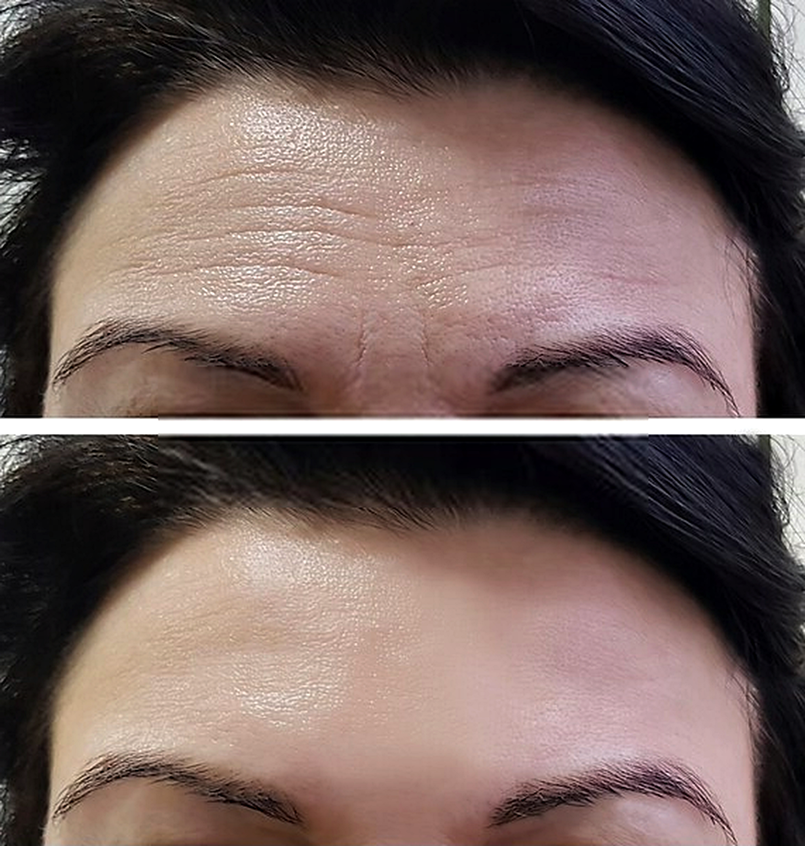We know the golden rules against wrinkles. No smoking, no drinking, UV protection. But what else can we do to smooth out wrinkles?
Wrinkles – where do they come from?
We’re in a boat. Because we all get wrinkles. Some more, others less. But what actually decides whether our skin stays smooth for a long time or creases quickly? Environmental influences, our genes, our lifestyle? Studies have shown that only 20 to 30 percent of skin aging is genetically determined. The remaining 70 to 80 percent are caused by environmental influences, such as UV radiation and air pollution, but also by the individual lifestyle – nutrition, nicotine, alcohol and sleeping habits play a role in the formation of wrinkles. We still put up with smile lines or small wrinkles. However, the forehead wrinkles are particularly in the focus of criticism. In our special on the subject of wrinkles, we tell you how to keep these nerve saws in check on your forehead.
Cream away wrinkles – does that work?
- The promises sound tempting: “Reduce wrinkle depth by 50% in just 4 weeks”? Give me the miracle cream! Some prophecies of the cosmetics industry give a little too far, but with effective skin care, which is adapted to the skin type and age, you can achieve a lot.
- Retinol, for example, is a proven anti-aging booster that has been specially integrated into night care products. Retinol, however, is an active ingredient that should be used sensitively. In Germany it may only be used in a maximum concentration of 0.3 percent, as retinol can irritate the skin severely. Up to one percent is permitted in the USA. Important: Start with a low dose and slowly get the skin used to it. In addition, the active ingredient makes the skin more sensitive to light – apply a high UV protection (preferably LSF 50) during the day.
- Hyaluronic acid supplies our skin with moisture – which it urgently needs in order not to wrinkle. We have tested face cream with hyaluronic acid and explain how hyaluronic acid can cushion our wrinkles.
- Q10 is an antioxidant that protects us. Free radicals attack the structure of our skin. Antioxidants such as coenzyme Q10 help them stay smooth for longer.
- Collagen is regarded as the ultimate anti-aging weapon. In the hype: collagen drinks that act as beautifiers from the inside and animate our connective tissue fibres to hold out.
- Rhamnose is a plant sugar molecule from birch trees that is said to stimulate the production of new skin cells.
- A study last year astounded us: sun cream reverses wrinkles. By regularly applying sun cream, skin damage is not only prevented, the overall appearance of the skin improved in one trial – facial expression lines were reduced and pigmentation spots less visible.
Which foods help against skin aging?
We can also rebel internally against skin aging – with the right foods. A high:
- Cocoa beans! They have a higher content of antioxidants than green tea or red wine. Studies have shown that regular consumption of cocoa delays skin aging. How this skin effect comes about has not yet been clarified. However, we do not mean the highly sweetened cocoa that we mix with milk for Sunday breakfast. Sugar has a negative effect on our cells and makes us age faster. We think: pure cocoa powder which is rich in flavonoids which can protect us from the harmful effects of UV radiation. This also applies to dark chocolate. The higher the percentage of cocoa, the higher the flavonoid content.
- Oatmeal! The proportion of silicon, which is responsible for the elasticity of the skin, decreases with increasing age. Oat flakes are great silicon flakes
- Coconut water! Coconut milk contains a lot of kinetin – an effective anti-aging substance for our skin.
- Dark berries! Elderberries, black currants, blackberries – they contain plenty of antioxidants. They protect our cells and fight bravely against free radicals.
- Nuts! Walnuts are full of omega-3 fatty acids, proteins and alpha-linolenic acids, which can slow down our skin aging.
Vitamin C protects our skin from free radicals. It is found in citrus fruits such as lemons and oranges, but also in broccoli and cabbage. Vitamin E is found in fish, peppers, nuts and vegetable oils. The cell protective vitamin protects the body cells from harmful influences, for example from aggressive oxygen compounds.
Minimally invasive wrinkle removal
There are various methods to reduce wrinkles at least temporarily using minimally invasive methods. It does not always have to be Botox, even modern methods that only gently lift the face can do this. Anyone who decides to do so should seek intensive advice from a dermatologist who specialises in aesthetic medicine. One of the methods, for example, is the:
- Liquid Lifting, the injection of hyaluronic acid that lasts for about 12 months. The hyaluronic acid needs time to unfold in the skin layers, this is achieved after about 3 months. Suitable for fine lines around the mouth and on the forehead, but also in the nasolabial folds (from the nose to the corner of the mouth) and marionette folds (from the corner of the mouth to the lower jaw).
- The micro-liposome technique works with the body’s own fat cells, in which cells are taken from the thighs, buttocks or abdomen, broken down into their smallest components and then injected into the wrinkle with a micro-injection.
- Microneedling is also a rejuvenating method in which the top layer of skin is slightly damaged with a fine needle roller. The body’s reaction is called “repairing” and it releases collagen, elastin and hyaluronic acid, which tighten the skin.
- Slack chin and cheek contours and hanging cheeks can be tightened by a thread lift. It strengthens the connective tissue and the material of the threads – polylactic acid is often used – stimulates the natural production of collagen.

